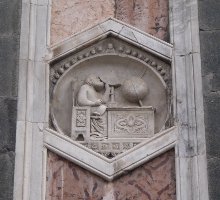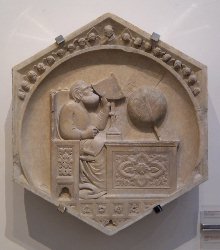![]() Nachstehend werden etwa in Originalgröße (abhängig von
Bildschirmgröße und -auflösung) Münzen gezeigt, die sich auf
Mathematiker beziehen oder einen Bezug zur Mathematik aufweisen. Durch Anklicken
des Abbilds einer einzelnen Münze wird beim ersten Mal ein neues Browser-Fenster
geöffnet und die Münze erscheint in dreifacher (linearer) Vergrößerung.
Die Münzen werden alle im selben Browser-Fenster angezeigt, das allerdings nicht
automatisch im Vordergrund erscheint.
Nachstehend werden etwa in Originalgröße (abhängig von
Bildschirmgröße und -auflösung) Münzen gezeigt, die sich auf
Mathematiker beziehen oder einen Bezug zur Mathematik aufweisen. Durch Anklicken
des Abbilds einer einzelnen Münze wird beim ersten Mal ein neues Browser-Fenster
geöffnet und die Münze erscheint in dreifacher (linearer) Vergrößerung.
Die Münzen werden alle im selben Browser-Fenster angezeigt, das allerdings nicht
automatisch im Vordergrund erscheint.
Weitere Beiträge zur vorliegenden Münzsammlung sind ausdrücklich erwünscht. Zu diesem Zweck wären beide Seiten der Münzen mit einer Auflösung von 300 dpi einzuscannen, verlustfrei zu speichern (bmp- bzw. pcx-Format) und per Mail an den Autor (wolfgang.volk@berlin.de) zu senden. Der Beitragende wird erwähnt und ein Verweis (Link) angelegt werden, wenn dem nicht explizit widersprochen wird.
![]() Below coins are shown approximately in original size (depending on the screen size and
resolution) which show mathematicians or are related to mathematics in some way.
Clicking on an image of such a coin for the first time a new browser window will open
showing the coin linearly magnified by factor 3. Subsequent coins will appear in the same
browser window which will not automatically pop up.
Below coins are shown approximately in original size (depending on the screen size and
resolution) which show mathematicians or are related to mathematics in some way.
Clicking on an image of such a coin for the first time a new browser window will open
showing the coin linearly magnified by factor 3. Subsequent coins will appear in the same
browser window which will not automatically pop up.
Further contributions to this coin collection are welcome. For this reason, please, scan both sides of such coins with a resolution of 300 dpi, store it in a format without loss of information (formats bmp or pcx) and send it per mail to the author (wolfgang.volk@berlin.de). The contributor will be mentioned and a link to the homepage will be set if not explicitely opponed to this procedure.
 |
|
 |
|
 |
|
 |
Auf der Wertseite (Avers) der Münze ist auf vier Seiten eines
quaderförmigen Gebildes die Aussage des
Satzes von Hahn-Banach
wiedergegeben:
Übrigens stellt die Goldmünze die Aussage des
Banachschen
Fixpunktsatzes
On the obverse of the coin there is a rectangular object with the proposition
of the Hahn Banach
theorem on its faces,
which means:
Moreover the golden coin mentioned above shows the statement of
Banach's fixed point
theorem: |
 |
|
 |
|
 |
|
 |
|
 |
|
 |
|
 |
|
 |
|
Siehe auch / cf. also Carl Friedrich Gauß (1777-1855) auf Briefmarken, Münzen und Geldscheinen (only in German)
 |
|
 |
|
 |
|
 |
|
 |
|
 |
|
 |
|
 |
|
 |
|
|
 |
|
 |
|
 |
Der untere Teil der Rückseite ist mit ein Porträt, der Name von P. dal Pozzo Toscanelli zusammen mit der Aussage "Direkter Weg nach Osten den Atlantik kreuzend" versehen. Dazwischen ist seine Landkarte von 1474 wiedergegeben, auf der bezeichnenderweise der Kontinent Amerika völlig fehlt. Die Karte ist nordorientiert, was an der am oben Rand gemachten Angabe septentrio (poetisch für Norden). Weitere Angaben sind am oberen Rand oriens und am unteren Rand auster. Die Karte zeigt noch folgende geografische Angaben: Cathay (Nordchina), Mangi (Südchina), Cipango (Japan), Tropicus cancer (Nördlicher Wendekreis, Wendekreis des Krebses), Mare oceanum und Africa. Die Übersetzung der spanischen Aussagen ins Deutsche wurde dankenswerterweise von Jörg Knobloch aus Berlin vorgenommen.
The lower part of the reverse face shows a portrait, the name of P. dal Pozzo Toscanelli with the quotation "Direct way to the East crossing the Atlantic Ocean". In between there is a map from 1474 by himself. Certainly there is no continent America. The map is oriented to North which becomes clear due to the word septentrio (poetical for North) at the upper edge. Furthermore the words oriens at the upper and auster at the lower edge appear. The map shows also the following geigraphic names: Cathay (Northern China), Mangi (Southern China), Cipango (Japan), Tropicus cancer (Tropic of Cancer, Northern tropic), Mare oceanum and Africa. The translation of the Spanish phrases (to German) was performed by Jörg Knobloch from Berlin. |
 Gionitus am Campanile des Florentiner Doms / Gionitus at the campanile of the cathedral of Florence  Gionitus im Museum L'opera del Duomo / Gionitus in the museum L'opera del Duomo |
 |
|
 |
|
 |
Die Übersetzung der chinesischen Schriftzeichen wurde dankenswerterweise von Ling Chung Shu aus Berlin vorgenommen.
The translation of the Chinese symbols (to German) has been performed by Ling Chung Shu from Berlin. |
 |
Die Übersetzung der chinesischen Schriftzeichen wurde dankenswerterweise von Ling Chung Shu aus Berlin vorgenommen.
The translation of the Chinese symbols (to German) has been performed by Ling Chung Shu from Berlin. |
 |
ist der kugelförmigen Masse aufgeprägt. Sie zeigt die Äquivalenz von Energie und Masse. Die Randinschrift lautet: NICHT AUFHÖREN ZU FRAGEN, was eine verkürzte Variante des Zitats "Wichtig ist, dass man nie aufhört zu fragen." ist.
can be read on the shape of the mass. It shows the equivalence of energy and mass. The inscription of the edge reads like: Don't stop to ask, which is a shorten variant of A. Einstein quotation "It's essentially to never stop to ask.". |
 |
|
 |
|
1d) Im Jahre 1995 fand eine Währungsreform - sogenannte Denominierung - statt, seitdem hat ein Złoty den 1000-fachen Wert wie zuvor. (Zurück zum Bezug)
1e) in 1995 a currency reform took place, the value of the new Złoty corresponds to 1000 old ones. (Back to the reference)
2d) Die Abbildungen der Münze(n) ist einem Dokument der Griechischen Nationalbank (Τραπεζα τησ Ελλαδοσ, Bank of Greece) entnommen.
2e) The images of the coin(s) have been taken from a document of the Bank of Greece (Τραπεζα τησ Ελλαδοσ).
| Back to the main page | Created by
Wolfgang Volk in August 2006 Last addition on February 18th, 2018 | ||||